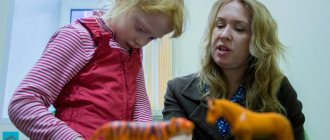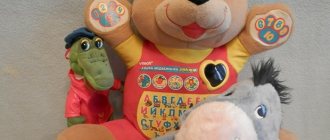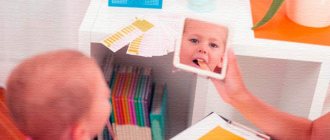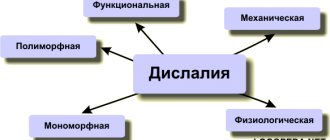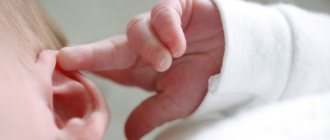Compiled by: teacher - speech therapist MADOU TsRR - kindergarten No. 50 of the city of Tyumen S.S. Badryzlova
A change in the timbre of the voice, which becomes dull and acquires a nasal tone, is called rhinophony by experts. This is due to the peculiarities of the soft palate, which in a child may not be mobile enough. With a sedentary palate, the so-called velopharyngeal ring does not form, which, during speech exhalation, is designed to prevent air from escaping through the nose. As a result, the child’s voice ceases to be light, and speech loses expressiveness.
What is the cause of this disorder?
There are two types of rhinophony: open and closed. The first may be congenital if the baby was born with a shortened soft palate. However, sometimes the problem is associated with an infectious disease such as diphtheria or influenza, complicated by paralysis or paresis of the palate. Acquired rhinophony may also appear after the baby’s pharyngeal tonsils are removed: postoperative scars tighten the palate and limit mobility.
Therefore, mom and dad should listen to what the voice of the recovering person sounds like. If he has a persistent nasal tone, it is better for you to consult an otolaryngologist or speech therapist. Open rhinophonia is very common in weakened children of the asthenic type with sluggish articulation and shallow breathing. In this case, the soft palate, due to its muscle weakness, simply does not reach the wall of the pharynx. That's why the baby has a pronunciation. And since such a feature is unusual for the Russian language, unlike French, it is better to correct the defect.
Closed rhinophonia occurs in diseases of the nasopharynx: proliferation of adenoids, polyps, and also due to a curvature of the nasal septum. Sometimes a simple runny nose is enough for the baby to have problems with his voice. It is good if the symptoms of rhinophony go away along with the disappearance of the symptoms of a cold or allergy. But unfortunately, this does not always happen. Recently, it has become increasingly common to observe that even after recovery, the child’s voice remains dull, monotonous, and muffled, although there seems to be no apparent reason for this. In this case, experts talk about habitual closed rhinophony.
In this case, normal physiological breathing is disrupted: the child cannot breathe through his nose, his mouth is constantly open. That is, there is a real threat of a cold. In addition, the baby does not receive enough oxygen, so he quickly gets tired, loses the ability to concentrate, experiences headaches, dizziness, and sleeps poorly. A dull, distorted voice timbre also creates certain psychological difficulties in communication for a child: he is embarrassed to speak, avoids peers, and becomes withdrawn. Irritability, tearfulness, and excessive touchiness appear in his behavior.
How to fix?
To eliminate the nasal voice (open rhinophony), both the baby, the speech therapist, and, of course, the parents will have to work hard. Now our common task is to activate the soft palate and make it move. And here you will need a massage. If the baby is too small, help him complete this procedure.
• First, wipe your index finger on your right hand with alcohol. And then, with its pad, begin to stroke and rub in the transverse direction the mucous membrane at the border of the soft and hard palate. • Do the same movements while pronouncing the sound “a”. • Make several zigzag movements along the border of the soft and hard palate from left to right, and then the same, but in the opposite direction. • Massage the soft palate using your index finger in jerking movements. If your child is big, he can do the same techniques himself. In this case, the main performer of the massage will be the tip of the child's tongue.
To ensure that your child does everything correctly, conduct a rehearsal with him with a mirror in his hand. Looking at his reflection, the baby should open his mouth wider and do each of the four exercises with his tongue. If everything works out for him, let him continue with his mouth closed. Such training is possible at any time and anywhere, and unnoticed by everyone around you! And those who massage more often are more likely to achieve the desired result.
In addition to massage, exercise is also necessary. Here are some of them. 1. Give your child a glass of warm water and encourage him to drink it in small sips. 2. Let him demonstrate how well he can gargle by taking portions of warm water into his mouth. 3. Now invite the child to open his mouth wide and cough: while exhaling, at least 3 times. 4. Then, from the same starting position - with your mouth wide open - try to yawn together. 5. Try to do the next task energetically and exaggeratedly, pronouncing the sounds with a firm attack: “a”, “o”, “u”, “e”, “i”, “y”.
To get rid of closed rhinophony or the lack of nasal resonance on the sounds “n”, “m”, you will have to take decisive action. Firstly, it is necessary to eliminate the reasons that led to this phenomenon. That is, to get rid of polyps, adenoids, deviated nasal septum, swelling of the nasal mucosa with allergic rhinitis and runny nose. Secondly, physiological and speech breathing should be restored. By the way, work on breathing should also be done with open rhinophony.
Speech games to eliminate nasalization
Fringe in the wind
We will replace threads with cotton wool with a sheet of paper cut into fringes. The baby needs to blow on this fringe so that it deviates: the more, the better.
Let's play ball
The tongue loves playing with a big round ball! Demonstrating this, the baby will have to puff out his cheeks widely and evenly. The ball deflated! The ball gets tired too. At the same time, it loses its roundness and air comes out of it. Tell your child that now they need to strongly inflate their cheeks, and then slowly release the air, stretching out their lips with a tube.
Let's set up the pump
He will help us inflate the ball! Let the baby show with his hands how the pump works, and voice the picture, often pronouncing the sound “s”: the lips are stretched, the teeth are clenched, and the tongue rests on the front teeth. The air comes out in strong bursts.
Football
Who doesn't like to play football? Not the tongue! He likes to score goals. So, let's put two cubes on the table away from the baby. This will be the gate. And put a piece of cotton wool closer to the baby. And here is the task - to accurately “score goals” by blowing on a tampon with your tongue inserted between your lips, trying to hit the target. The cheeks should not swell too much. The air flows down the middle of the tongue. Make sure that your child does not inadvertently inhale cotton wool while performing this exercise.
Pipe
And the tongue can play the pipe well. The melody is not audible at all, but you can feel a stream of air escaping from the pipe. The baby will have to roll his tongue into a tube and blow into it. The child checks the presence of a stream of air on his palm.
1.General information
Such a well-known phenomenon as nasality, only at the level of ordinary consciousness or pseudo-medical practices may seem self-evident, simple, and does not require special explanation. In reality, this complex acoustic phenomenon is caused by pathological changes in the unique phonation-articulatory (speech-sound) apparatus of a person, which can arise under the influence of many reasons and take a number of significantly different clinical forms.
It should be noted that the scope and content of the very concept of “nasal”, as well as the terminology used in texts devoted to this phenomenon, differ depending on which medical specialty the publication relates to - phoniatry, speech therapy, pediatric or general otorhinolaryngology, ENT -surgery, etc. In particular, such terms as rhinolalia (“nasal speech”), rhinophonia (“nasal sound”), palatophonia/lalia (palatal sound/speech) are used with slightly different meanings. In English-language literature one can also find the expression “hypernasal speech”, equivalent to the Russian “speak through the nose”, etc.
In general, nasal voice and/or speech is a serious problem that impairs social functioning, reduces quality of life and, even in moderate severity, precludes suitability for a number of professions. Eliminating this violation is usually quite difficult; it requires time and significant effort, incl. from the patient himself.
A must read! Help with treatment and hospitalization!
2. Reasons
A child learns to pronounce individual phonemes, words and entire phrases clearly and correctly over several years. From the point of view of biological evolution and adaptation, this is an impermissible, but at the same time, a forced, necessary waste of time, since speech became one of the most important factors that first ensured the survival of the species Homo Sapiens, and then its dominant position on the planet. The most complex act of phonation and articulation involves the vocal cords, larynx, oral and nasal cavity, teeth, tongue, many muscles, cranial resonators - sinuses (four pairs of paranasal sinuses). An anomaly or pathology in any of these elements can lead to dysphonia, dysarthria, dyslalia and other speech disorders, including nasality.
Rhinolalia can be either congenital or acquired. There are also several degrees of severity.
The most common causes of twang:
- intrauterine anomalies in the development of the nasal passages, soft and hard palate;
- curvature of the nasal septum;
- traumatic deformations and displacements of osteochondral structures;
- hypertrophic, hyperplastic, neoplastic growths (polyps, adenoids, tumors and other mechanical blocks in the airways);
- defects due to surgical interventions;
- swelling in acute or chronic inflammation of the nasopharynx;
- adhesions and other fibrosing processes;
- tissue breakdown due to specific aggressive destructive infections (tuberculosis, syphilis);
- dysfunction or failure (paralysis, paresis, etc.) of the soft palate and/or muscles involved in articulation - this factor is especially significant in the case of acute cerebrovascular accidents.
Visit our Otolaryngology (ENT) page
4.Treatment
The above-mentioned difficulty in eliminating nasality lies, first of all, in the fact that in almost all cases (regardless of the patient’s age and the nature of the problem), a multidisciplinary approach is required. In parallel with surgical intervention (removal of mechanical obstacles or anatomical defects), a course of speech therapy correction and physiotherapeutic procedures (electrotherapy, massage stimulation, mechanical obturators, etc.) is carried out. It is a comprehensive therapeutic strategy, combined with the willingness of the patient (or his parents, if we are talking about a child) to comply with all instructions and prescriptions, that provides a favorable prognosis.
3. Symptoms and diagnosis
As stated above, nasality from an acoustic point of view is a significant distortion of the natural amplitude-frequency characteristics of speech, timbre coloring and clarity of accents for humans. In simpler terms, the voice becomes dull and speech slurred; words are pronounced “in the nose”, i.e. the sound “m” sounds like “b” or “mb”, the sound “n” sounds like “d”, the sound “k” sounds like “g”, etc.
Depending on how the exhaled sound stream is distributed, carrying wave oscillations of audible frequency, a distinction is made between open nasality (part of the flow goes through the nose, part through the mouth) and closed (the nasal passages and entrances to the resonant sinuses are completely blocked, articulation and phonation are carried out exclusively by the mouth ). Open is much more common.
Each of these types of nasal sounds, in addition, can be anterior (the nasal passages are blocked) and posterior (the choanae orifices connecting the nasal passages to the oral cavity are blocked).
Statement of the very fact of nasal sound, assessment of its severity and character (open, closed, front, back, mixed) is not difficult for a specialist - it is enough to hear a few phrases from the patient. However, identifying the causes in some cases turns out to be much more difficult. Along with the standard examination of the ENT organs, radiographic and tomographic examinations, nasometry (measurement of the proportion between the oral and nasal sound flows), and less often endoscopy and other studies are prescribed.
Simpler functional tests are also practiced, which are especially valuable when examining young children (test with a mirror, test of pressure on the back of the nose, and many others).
About our clinic Chistye Prudy metro station Medintercom page!
